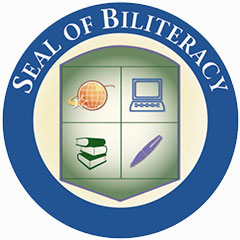November 16, 2017
The Seal of Biliteracy
Caps and gowns, pomp and circumstance, faculty and family buzzing about students’ incredible achievements. Graduation ceremonies never fail to inspire. While some students graduate with honors, a testament to the extra requirements they’ve met, others are awarded the Seal of Biliteracy, “a statement of accomplishment that helps to signal evidence of a student’s readiness for career and college, and for engagement as a global citizen” (Seal of Biliteracy Guidelines, 2015). Given by the states’ departments of education or local districts, the Seal of Biliteracy is an award given to high-school seniors upon graduation in recognition of having achieved the state-determined level of proficiency in English as well as one or more additional languages—certifying their biliteracy for future employers and universities.
Originating in California, the Seal of Biliteracy has been approved in 28 states and is in the initial stages of approval in 12 states and under consideration in two more states. Recommendations for implementation were drafted by four national organizations: The American Council on the Teaching of Foreign Languages (ACTFL), The National Association of Bilingual Education (NABE), the National Council of State Supervisors for Languages (NCSSFL), and the Teaching of English to Speakers of Other Languages (TESOL) International Association.

What are the benefits of earning the Seal of Biliteracy?
All students are eligible to earn the Seal of Biliteracy and, according to the guidelines, the focus is on achieving the level of proficiency required for English and one or more other languages, acknowledging that the level of proficiency may be different for these languages. The options for demonstrating language proficiency need to show a student’s ability to use the language, not simply show knowledge of it.
An understanding of the true benefit of being awarded the Seal of Biliteracy was perhaps best expressed by this response from a student being asked about it by Chicago Tribune reporter Diane Rado: “When asked I tell someone that I got a four or five on the Spanish Advanced Placement Exam, they say, ‘That’s nice.’ They don’t really know what that number means or how hard the test was. When I say that I received the Seal of Biliteracy, they understand that I have skills in two languages—even my boss gets it and is impressed.”
Guidelines and recommendations
The Seal of Biliteracy includes guidelines and multiple recommendations for states to evaluate students’ proficiency in English, including state English language arts assessments for all students and state English language development assessments for English Learners. Recommendations for languages other than English include the Advanced Placement Exam, the International Baccalaureate Exam, and several others.
In addition to recommendations for states, the Seal of Biliteracy guidelines also recommend that students keep a portfolio of their language performance, tracking improvement and progress toward the level required by their state. Among the elements suggested for the portfolio is an assessment measure outside those provided for specific courses.
Empowering students
Having students track their own improvement and progress toward the level required by their state can empower students to influence their own path toward mastery. With Renaissance Accelerated Reader and guidance from educators, students can select books in English or Spanish that are meaningful and relevant to them and driven by their own interests. They can also print their own TOPS reports to keep in their portfolio, giving them the opportunity to track the book level and percentage correct for each book’s reading comprehension quiz. In addition, educators can print Student Performance Record reports at regular intervals during the school year, providing a summary of all the books students have read as well as book levels and percentages correct on reading comprehension quizzes by language, which students can also keep in their portfolio. These reports empower students, which is the true goal of student agency.
Imagine students taking ownership of their learning in two languages. Now that is impressive!
Does your school or district encourage students to achieve the Seal of Biliteracy? What are your thoughts on the topic? Let us know in the comments below, post on our Facebook page, or tweet us at @RenLearnUS!


